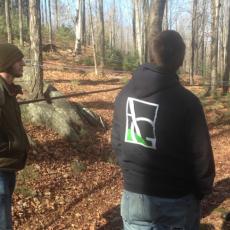If you are a devotee of New England sugar houses and their distinctive seasonal crop, you may soon be eating your syrup-drenched pancakes along with a side order of concern.
Kristina Stinson, plant ecologist at the University of Massachusetts, recently received a two-year, $149,800 grant to study the impact of climate change on the quantity and quality of sugar maple sap, including its chemical composition.
The researchers she works with believe this is the first study to look at the effect of climate change on sap quality, its sugar content and chemistry as opposed to flow and volume, and the first to investigate how red maple compares to sugar maple as a source for sap.
Stinson and colleagues hope to predict maple syrup quality under future climate conditions and explore a variety of management strategies.
Climate change is likely to affect maple syrup production by influencing tree health, the timing and duration of the tapping season, the quality of sap, and ultimately the availability of trees to tap. Her research group is working to understand these effects, especially the relationship between climate and sap quality.
Extending hands-on knowledge to students in their own backyard
In the meantime, a study tour of the Davenport Maple Farm has been an integral part of the capstone course for seniors and graduate students in forest ecology and conservation (NRC 540: Forest Resources Management) since 1997. Paul Barten, Professor of Forestry and Hydrology, says, “The focus is on sugar bush silviculture, forest health, and the production of maple syrup and other value-added products. Students learn how five generations of the Davenport family have made their living from the land with maple products, woodlot management for cordwood and saw logs, dairy, livestock, and hay operations, and their seasonal restaurant business. Their deep roots and creative adaption to changing markets and new opportunities is a case study in conservation and sustainability.”
New labeling system: So long, “Fancy and Grade B”
In an attempt to standardize the grading system for maple syrup, both nationally and internationally, a few years ago the USDA announced some changes. Pure maple syrup is graded according to Federal USDA regulations, and is based on both color and flavor. All syrup available to the public is Grade A, and then further classified by color.
Characteristics of each grade
Golden Color, Delicate Taste. This light syrup has the mildest maple flavor and is usually made early in the season.
Amber Color, Rich Taste. Still light in color, this syrup has a more full-bodied maple flavor.
Dark, Robust Taste. This syrup is for those who prefer a substantially stronger maple flavor.
Very Dark, Strong Taste. This bold flavored syrup is ideal for cooking and baking, and is made late in the season.
Massachusetts does not have grading laws, so most producers follow the USDA regulations (which are voluntary).
As you chow down your pancakes dripping with freshly-made maple syrup, it is up to you to decide if you like the delicate or more robust taste...it’s all Grade A, local and a sure rite of spring in Massachusetts.
For more information, go toMassachusetts Maple Producers Association



